On The Day
The History
Preserving The Past For The Future

In March 1865, the Battle of Averasboro (also called Averysborough, Smith's Mill and Black River) was the first deliberate, tactical resistance to the infamous march of Federal forces through Georgia and the Carolinas. The battle was fought on the plantation lands of the John Smith family four miles south of the Cape Fear River town of Averasboro.
Today the cannons are silent. The battle-scarred plantation lands are quiet.
But the memory remains of those both military and civilian who suffered and died during the Battle of Averasboro. Their valor and sacrifice deserves to be perpetually honored.
The Battle of Averasboro began during the afternoon of March 15, 1865. Soldiers under the command of Colonel Alfred Rhett were deployed as the first of three defensive lines. Forward of the first line were skirmishers positioned to engage the advancing Union cavalry commanded by Brigadier General Judson Kilpatrick, which was in the forefront of General Sherman's left wing of 30,000 officers and men. Kilpatrick's 9th Michigan Regiment drove the Confederate skirmishers back toward the defensive line but were halted by additional Confederates reinforcing from the Confederate defensive positions. Sharp exchanges occurred and the situation stabilized by nightfall.
At 6:00 am on the morning of March 16, a buildup of 20th Corps Union brigades on line began with over 12,000 troops to be committed against the approximately 2800 Confederates on the first and second defensive lines. Heavy fighting occurred during the morning, highlighted by simultaneous fronted and flanking assaults against the Confederate right by two Union brigades. This and a preceeding artillery preparation resulted in the loss of over 220 Confederates--either killed, wounded, or captured--and the forced withdrawal from the first and second Confederate defensive lines. As the Confederates withdrew under pressure to their prepared and partially occupied third line, General Sherman committed elements of the 14th Corps abreast of the 20th Corps. Brigades of the 14th Corps attempted to again flank the Confederate right but were decisively stopped with significant casualties by Confederate General Joe Wheeler's dismounted cavalry. Sporadic Union attacks continued without success along the third line until nightfall.
General Sherman anticipated a major assault against the Confederate third defensive line at dawn on March 17th. The defending Confederate General William Hardee, having succeeded in his mission of delaying and disrupting the advance of General Sherman's left wing, withdrew his troops under cover of darkness the night of March 16th and conducted a forced march to the vicinity of Bentonville. There these Confederate veterans of the Battle of Averasboro would join General Johnston and his army to surprise the Union 14th and 20th Corps and begin the Battle of Bentonville on March 19, 1865.
Casualties for the fighting at Averasboro were high for both armies. Killed and wounded were approximately 650 Union and 800 Confederate casualties. Approximate numbers of troops committed were Union 25,000 and Confederate 8,000.
- Monday
- Closed
- Tue - Sat
- -
- Sunday
- Closed
REGISTER TO LEARN MORE ABOUT UPCOMING EVENTS & NEWS
Thank you for contacting us.
We will get back to you as soon as possible
We will get back to you as soon as possible
Oops, there was an error sending your message.
Please try again later
Please try again later
